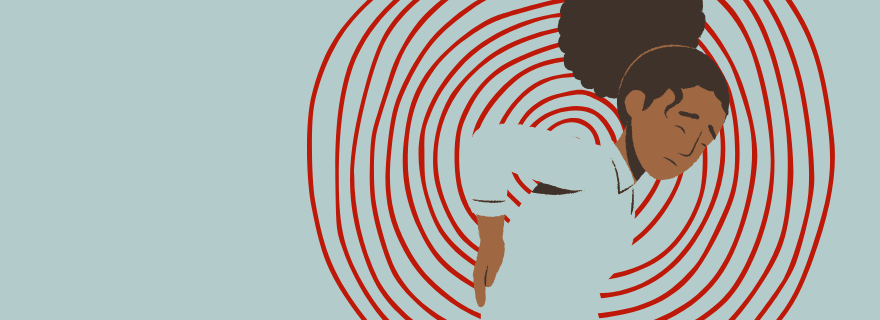
Managing chronic pain? ‘With a data driven approach you can tailor treatment to the individual’
Exercising less, skipping parties and struggling at work: the expectation of chronic pain and itching can lead to avoidance behaviour. But this is by no means the case for everyone with chronic pain, as PhD candidate Gita Nadinda discovered. What does this mean for healthcare?

Imagine falling badly right in front of a group of colleagues. You land hard on a stone staircase, and while your colleagues rush over with worried faces, you quickly get back on your feet. ‘I’m fine!’ you call out, hurrying away. The next day, you are covered in bruises, and your tailbone is sore. How is it that you hardly felt any pain at the time of the fall?
Pain as a barrier
When Gita Nadinda heard this example in her Health Psychology course during her bachelor’s degree in Psychology, she became fascinated by pain. Especially by the idea that pain is not fixed but shaped by countless mechanisms. ‘If you hurt yourself, there are many psychological and social reasons why you might not feel the pain as strongly. It had never occurred to me before that so much lies beneath our physical sensations.’ After finishing her bachelor’s, she volunteered at an organisation for people with physical disabilities. ‘I worked a lot with people who had had a limb amputated. For many of them, pain was the biggest barrier to wearing a prosthesis or continuing with physiotherapy.’
Chronic pain and itch
For her master’s thesis, Nadinda studied the influence of psychological interventions such as cognitive behavioural therapy on pain perception before and after surgery. She was supervised by Professor of Experimental Health Psychology Madelon Peters at Maastricht University, who later, together with Leiden psychologists Andrea Evers and Antoinette van Laarhoven and Johannes Vlaeyen from Maastricht University, also supervised her doctoral research. Nadinda was part of the Mind-Body Team led by Andrea Evers, within the New Science of Mental Disorders consortium, funded through a Gravitation Grant. On 10 September, Nadinda will defend her dissertation Nexus, Uncovered: On the Relations Between Expectancy, Avoidance, and Somatic Sensations. In her research, she looks not only at the relationship between expectation and avoidance in chronic pain, but also in itch.
‘Chronic pain can have a major impact on your social life’
Pain and itch in daily life
About a quarter of Dutch people live with chronic pain and 17 percent suffer from chronic itch. Among those over fifty, as many as 30 percent experience persistent itching complaints. Pain and itch can put a significant strain on daily life. ‘Chronic pain demands a lot of attention, making it harder to function at work. People also sometimes stop exercising out of fear of worsening the pain, even if they used to really enjoy it,’ says Nadinda. ‘Chronic pain also has a major impact on your social life. People often encounter a lack of understanding when they cancel plans again because of the pain. “Why don’t you just take some painkillers?” other people say. The belief that chronic pain is all in your head is still very common.’ People with chronic itch also face social stigma. ‘If someone scratches themselves a lot, others sometimes fear they have a contagious disease.’
Does pain lead to avoidance?
For her dissertation, Nadinda investigated the relationship between expectations of pain and itch and behavioral avoidance. In other words: does expecting pain mean that you will also try to avoid it? 'In the literature, the fear-avoidance model is often cited; the idea that people with chronic pain become afraid of the pain, start avoiding certain movements, and as a result experience even more pain. But there is still little empirical evidence that negative expectations really lead to avoidance.’
'There is still little empirical evidence that negative expectations also lead to more avoidance behaviour'
No avoidance of pain
To explore this further, Nadinda and her colleagues set up their own experiment. Healthy participants were told in the laboratory that they would feel pain from an electric stimulus, which forms a negative expectation. They could then choose: either play a difficult game and receive less pain, or play an easier version but experience more pain. ‘Again and again, we found that negative expectations did increase the pain experience, the nocebo effect but did not lead to avoidance of the pain.” In other words: people preferred to play the easier game even if it meant more pain. Expecting pain does not necessarily lead to avoiding it. But, Nadinda adds: ‘What participants avoided instead was the more difficult game. That is still avoidance behaviour.
Avoidance of itch
In a second experiment, Nadinda and her colleagues induced itch in participants by rubbing hairs of a tropical bean on their skin. Participants could try to avoid the itch by clenching their fist tightly for half a minute. Quite tiring, but the clenching prevented them from scratching. ‘There we saw that, even when participants expected only a little itch, they still chose to avoid it.’ Why did people avoid the expected itch, but not pain to the same extent? ‘That could also have been due to the design of the study. People were more willing to endure brief pain than to spend three minutes playing a complicated game. With itch, the cost-benefit balance was different.’
‘How expectation of pain and avoidance relate to each other varies greatly from person to person’
Data-driven treatment
Finally, Nadinda carried out a network analysis of people with chronic low back pain. Participants reported, five times a day over an extended period, on their pain, mood, expectation, and avoidance at that moment. ‘We looked at how all these factors influenced one another, both at group level and at the individual level. At the individual level we saw a lot of variation. For some people, expectation of pain did predict avoidance, but for others not at all, or the process worked the other way round.’ For her, this confirms the importance of an approach that has often been argued for in chronic pain research: tailoring treatment to the individual. ‘With a data driven approach, you gain insight into the links between all the factors, and you can act on them more effectively.’
Allergic to crab
Was she surprised that the participants in her research avoided pain less than theory would suggest? ‘Yes and no. Why not? I understand it better when I look at my own situation. I’m allergic to crab, but I love it. Sometimes I just eat it anyway and accept the allergic reaction.’ In the same way, she says, everyone sometimes does things that might lead to pain. Think of an injured runner who still trains for a marathon. ‘What causes pain can also bring joy. It’s always a matter of weighing the individual costs and benefits.’
